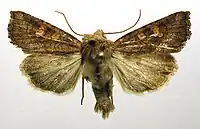Amphipoea fucosa
Amphipoea fucosa, the saltern ear moth, is a moth of the superfamily Noctuoidea, found in Europe. It was described in 1830, by the German entomologist Christian Friedrich Freyer, from two type specimen found in Sligo, Ireland and Deal, Kent. It is one of four species that are difficult to tell apart, requiring the examination of the genitalia. The larvae feed in the stems and roots of grasses.

| Amphipoea fucosa | |
|---|---|
.jpg.webp) | |
| Scientific classification | |
| Domain: | Eukaryota |
| Kingdom: | Animalia |
| Phylum: | Arthropoda |
| Class: | Insecta |
| Order: | Lepidoptera |
| Superfamily: | Noctuoidea |
| Family: | Noctuidae |
| Genus: | Amphipoea |
| Species: | A. fucosa |
| Binomial name | |
| Amphipoea fucosa (Freyer, 1830) | |
Description
The wingspan is 29–35 mm. It resembles the ear moth (Amphipoea oculea) but is larger, with the reniform orange red. The moth is univoltine, flying in August and September. At night it can be found at flowering ragwort (Jacobaea vulgaris), marram grass and rushes and also comes to light.[1][2]
The moth overwinters as an egg, and larvae can be found from May to June, where they feed in the stems and roots of various grasses. In the wild they have been found on common saltmarsh grass (Puccinellia maritima) and accept cock's-foot (Dactylis glomerata) and annual meadow grass (Poa annua) in captivity. Pupation takes about a month, in the soil by a root.[3][4][5]
Similar species
Requiring genitalic examination See Townsend et al.,[6]
- Crinan ear (Amphipoea crinanensis)
- ear moth (Amphipoea oculea)
- large ear (Amphipoea lucens)
- a hybrid between the saltern ear and the large ear has been recorded in the Outer Hebrides, Scotland.[5]
Taxonomy
Freyer, when describing the moth in 1830, placed it in the genus Amphipoea, which was raised by the Swedish anatomist Gustaf Johan Billberg in 1820. Amphipoea refers to Amphi – round, and poa – grass; i.e. the habitat. The specific name, fucosa, means either painted or spurious. Painted in the sense beautiful or copied as in counterfeit, or spurious, probably in the sense of a copy of Amphipoea oculea and not distinct from.[7]
References
- Kimber, Ian. "73.126 BF2358 Saltern Ear Amphipoea fucosa (Freyer, 1830)". UKmoths. Retrieved 7 August 2023.
- Goater, Barry (1983). Heath, John; Emmet, A Maitland (eds.). Amphipyrinae. In The Moths and Butterflies of Great Britain and Ireland. Volume 10. Colchester: Harley Books. pp. 236–7. ISBN 0-946589-01-1.
- Robinson, Gaden S.; Ackery, Phillip R.; Kitching, Ian J.; Beccaloni, George W.; Hernández, Luis M. "Search the database – introduction and help". HOSTS – A Database of the World's Lepidopteran Hostplants. Natural History Museum, London.
- Henwood, Barry; Sterling, Phil (2020). Field Guide to the Caterpillars of Great Britain and Ireland. London: Bloomsbury Publishing. p. 339. ISBN 978-1-4729-3358-4.
- Porter, Jim (1997). The Colour Identification Guide to the Caterpillars of the British Isles. 0-670-87509-0: Viking. p. 134.
{{cite book}}: CS1 maint: location (link) - Martin C. Townsend, Jon Clifton and Brian Goodey (2010). British and Irish Moths: An Illustrated Guide to Selected Difficult Species. (covering the use of genitalia characters and other features) Butterfly Conservation.
- Emmet, A Maitland (1991). The Scientific Names of the British Lepidoptera. Their History and Meaning. Colchester: Harley Books. pp. 213 & 216. ISBN 0 946589 28 3.
External links
- Savela, Markku. "Amphipoea fucosa (Freyer, 1830)". Lepidoptera and Some Other Life Forms. Retrieved June 28, 2019. Taxonomy
- Lepiforum e.V. Includes photo of genitalia
- De Vlinderstichting (in Dutch)